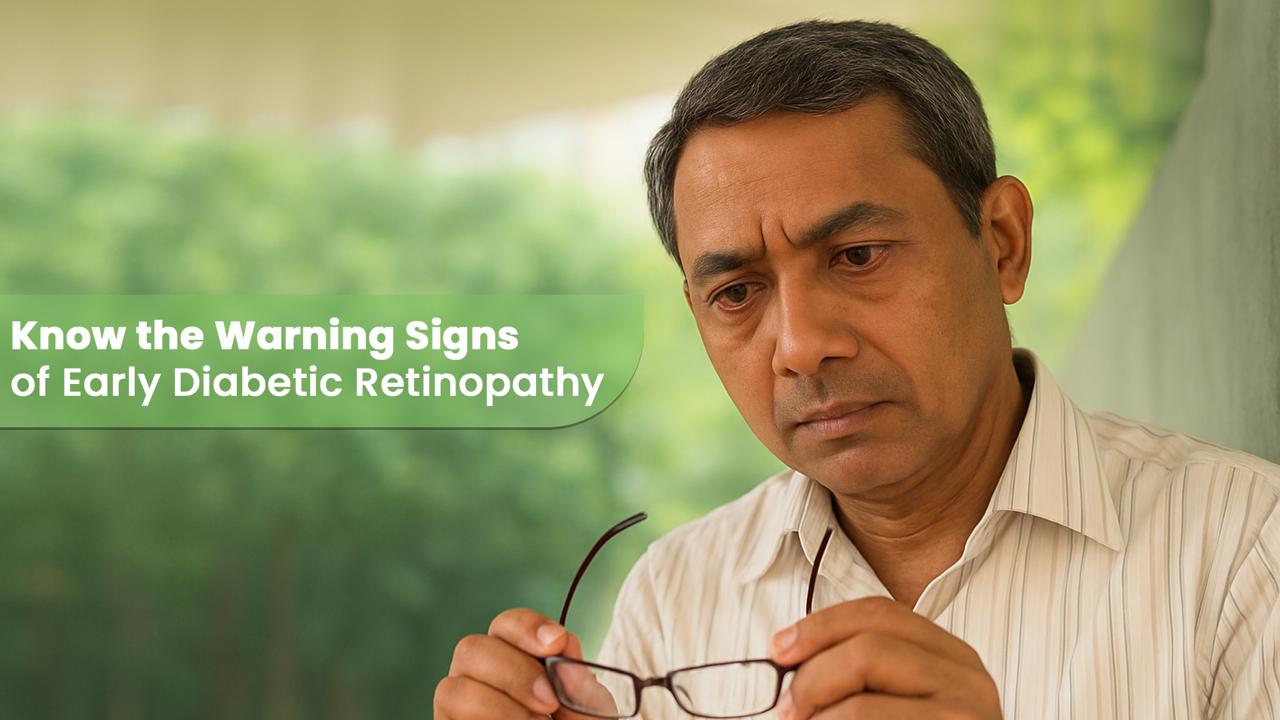
Know the Warning Signs of Early Diabetic Retinopathy
Know the Warning Signs of Early Diabetic Retinopathy | Rotary Techno Netralaya
Diabetes affects far more than just blood sugar levels, it can silently damage vital organs, including the eyes. One of the most serious vision-related complications of diabetes is diabetic retinopathy, a condition that damages the retina’s blood vessels. If left untreated, it can lead to irreversible vision loss. Unfortunately, many people overlook the early signs of diabetic retinopathy, as symptoms can go unnoticed at the beginning. Knowing what to watch for can make all the difference in preserving your sight.
What is Diabetic Retinopathy
Diabetic Retinopathy is a diabetic complication that happens when high blood sugar levels damage the tiny blood vessels in the retina, the light-sensitive tissue at the back of your eye. Over time, these damaged vessels may leak fluid or blood, swell or close off completely, preventing proper blood flow. At more advanced stages, abnormal blood vessels may grow on the retina, further threatening vision.
While both type 1 and type 2 diabetes can lead to diabetic retinopathy, the risk increases the longer you have diabetes, especially if your blood sugar is not well controlled.
Why Early Detection is Crucial
Catching diabetic eye disease early gives you the best chance to protect your vision. At the initial stages, treatments such as lifestyle changes, better blood sugar control and regular monitoring can slow or even halt progress. If ignored, diabetic retinopathy can advance to a stage where treatment becomes more complex , increasing the risk of vision problems caused by diabetes.
Early Signs You Should Not Ignore
In its early stages, diabetic retinopathy symptoms can be mild or even non-existent. However, there are warning signs and you should watch out for blurred vision. If it persists, it may be a sign of retinal damage. Damaged retinal blood vessels can cause patches of vision loss, appearing as dark or empty spots in your sight. Tiny spots, specks or cobweb-like shapes floating in your vision can be caused by bleeding within the eye, a possible sign of early diabetic retinopathy.
Are you facing difficulty seeing at night or any sudden vision changes? Any sudden change, such as distorted vision or a sudden decrease in clarity, calls for an immediate eye check-up.
Risk Factors for Developing Diabetic Retinopathy
Several factors can increase your risk, including poor blood sugar control, high blood pressure, high cholesterol levels, a long duration of diabetes, smoking and pregnancy in women with diabetes. By managing these risk factors, you can reduce the chances of developing diabetic eye damage.
How Diabetic Retinopathy is Diagnosed
The most effective way to detect early signs of diabetic retinopathy is through a comprehensive eye exam performed by an eye doctor, ophthalmologist. This may include dilated eye exam, which allows the doctor to examine the retina and optic nerve. Optical Coherence Tomography (OCT) provides detailed images of the retina. Fluorescein Angiography highlights blood flow in the retina to detect any leaks or blockages. At Rotary Techno Netralaya, our specialists use advanced diagnostic tools to ensure accurate detection of diabetic eye disease in its earliest stages.
Preventing Vision Loss from Diabetic Retinopathy
Keeping your blood sugar within target range reduces damage to retinal blood vessels. Monitor blood pressure and cholesterol. Both can worsen retinopathy symptoms if left unchecked. Quit Smoking, as it quickens blood vessel damage, including in the eyes. Schedule regular eye examinations. Annual screenings are essential, even if you have no symptoms. Manage overall health. A healthy diet, regular exercise, and proper medication adherence can protect both your eyes and your general health.
Treatment Options for Diabetic Retinopathy
If detected early, lifestyle adjustments and careful monitoring may be enough. In more advanced stages, treatments may include laser therapy to seal leaking blood vessels or shrink abnormal ones. Anti-VEGF Injections reduce swelling and slow disease progression. Vitrectomy is a surgical procedure to remove blood or scar tissue from the eye. The goal of treatment is to prevent further vision loss rather than restore lost vision, making early detection of diabetic retinopathy vital.
Trust Rotary Techno Netralaya
At Rotary Techno Netralaya, we believe diabetic retinopathy is one of the leading causes of preventable blindness worldwide, but it doesn’t have to be. By understanding the warning signs of diabetic eye disease, taking steps to control diabetes and scheduling regular eye exams, you can greatly reduce your risk of vision loss. Your eyesight is priceless, do not wait for symptoms to worsen. If you have diabetes, make eye health a top priority and seek our expert care. Trust Rotary Techno Netralaya and let our professionals take care of your precious eyes.
Stay Updates
Subscribe to our newsletter.
